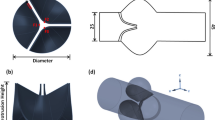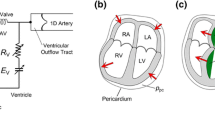Abstract
A mathematical model combining the coronary flow in the epicardial arterial tree and the intramyocardial circulation is presented. The epicardial arterial tree is represented by a resistive capacitive network based on its realistic anatomy. The intramyocardial flow is affected by the pump action of the contracting myocardium through the extravascular compressive pressure (ECP), which, in turn, affects the dynamic resistance and compliance changes based on the relationship between the transmular pressure and the cross-sectional area of a vessel. The model accounts for the autoregulatory mechanism of the intramyocardial compartments (arteriolar, microvascular and venular) and is structured according to the epicardial coronary anatomy. Realistic coronary epicardial arterial flow patterns are obtained, which compare well to experimentally measured data in six dogs under basal conditions and during reactive hyperemic response. Simulations of the average transmural flow in the three intramyocardial vascular compartments show that the flow in the arterial side is predominantly diastolic, with a systolic retrograde component, and is dominantly systolic antegrade flow in the venular side, consistent with experimental data. Interestingly, the transmurally average microcirculatory flow is continuous, with very small change throughout the cardiac cycle, and is practically insensitive to changes in the model parameters. The model presents a quantitative tool that describes the dynamic pattern of coronary flow in relationship to muscular and extravascular parameters.
Similar content being viewed by others
References
Armour, J. A., andRandall, W. C. (1971): ‘Canine left venticular intramyocardial pressures’,Amer. J. Physiol.,220, pp. 1833–1839
Baez, S., Lamport, H., andBaez, A. (1960):in ‘Flow properties of blood and other biological systems’ (Pergamon Press, Oxford) pp. 122–136
Baim, D. S., andGrossman, W. (1986): ‘Cardiac catheterization and angiography’ (Lea and Febiger, Philadelphia)
Baird, R. J., Goldbach, M. M., andDe La Rocha, A. (1970): ‘Intramyocardial pressure, the persistence of its transmural gradients in the empty heart and its relationship to myocardial oxygen consumption’,J. Thorac. Cardiovasc. Surg., 359, pp. 810–823
Best, C. H., andTaylor, N. B. (1966): ‘The coronary circulation’,in ‘The physiological basis of medical practice’ (Williams & Wilkins, Baltimore) Chap. 45, pp. 813–819
Beyar, R., Guerci, A. D., Halperin, H. R., Tsitlik, J. E., andWeisfeldt, M. L. (1989): ‘Intermittent coronary sinus occlusion following coronary arterial ligation results in venous retroperfusion’,Circ. Res.,65, pp. 695–707
Beyar, R., Kamminker, R., Manor, D., Ben Ari, R., andSideman, S. (1991): ‘On the mechanism of transmural myocardial compression and perfusion’in Sideman, S., Beyar, R., andKleber, A. G. (Eds.), ‘Cardiac electrophysiology, circulation and transport’ (Kluwer Academic Publishers, Springfield) pp. 245–258
Beyar, R., andSideman, S. (1987): ‘Time dependent coronary blood flow distribution in left ventricular wall’,Amer. J. Physiol.,252, pp. H417-H433
Bruinsma, P., Arts, T., Dankelman, J., andSpaan, J. A. E. (1988): ‘Model of the coronary circulation based on pressure dependence of coronary resistance and capacitance’,Basic Res. Cardiol.,83, pp. 510–524
Burattini, R., Sipkema, P., Van Huis, G., andWesterhof, N. (1985): ‘Identification of canine coronary resistance and intramyocardial compliance on the basis of the waterfall model’,Ann. Biomed. Eng.,13, pp. 385–404
Canty, J. M., Klocke, F. J., andMates, R. E. (1982): ‘Influences of vasomotor tone and coronary pressure on coronary capacitance’,Circ., Suppl II 66, pp. II-42
Chadwick, R. S. (1982): ‘Mechanics of the left ventricle’,Biophys. J.,39, pp. 279–288
Chadwick, R. S., Tedgui, A., Michel, J. B., Ohayon, J., andLevy (1990): ‘Phasic regional myocardial inflow and outflow: comparison of theory and experiments’,Amer. J. Physiol.,258, pp. H1687-H1698
Chilian, W. M., Layne, S. M., Klausner, E. C., Eastham, C. L., andMarcus, M. L. (1989): ‘Redistribution of coronary microvascular resistance produced by dipyridamole’,ibid.,,258, pp. H383-H390
Chilian, W. M., andMarcus, M. L. (1982): ‘Phasic coronary blood flow velocity in intramural and epicardial coronary arteries’,Circ. Res.,50, pp. 775–781
Chilian, W. M., andMarcus, M. L. (1984): ‘Coronary venous outflow persists after cessation of coronary arterial inflow’,Amer. J. Physiol.,247, pp. H984-H990
Cox, R. H. (1975): ‘Pressure dependence of the mechanical properties of arteries in vivo’,ibid.,,229, pp. 1371–1375
Dinnar, U. (1981): ‘Cardiovascular fluid dynamics’ (CRC Press, Boca Raton, Florida)
Dobrin, P. B., andRovick, A. A. (1969): ‘Influence of vascular smooth muscle on contractile mechanics and elasticity of arteries’,Amer. J. Physiol.,217, pp. 1644–1651
Doucette, J. W., Goto, M., Flynn, A. E., Husseini, W. K. andHoffmann, J. I. E. (1990): ‘Effects of left ventricular pressure and myocardial contraction on coronary flow’,Circ. (abstracts of the 63rd Scientific Sessions), pp. III-379
Downey, J. M., andKirk, E. S. (1975): ‘Inhibition of coronary blood flow by a vascular waterfall mechanism’,Circ. Res.,36, pp. 753–760
Fung, Y.: ‘Biomechanics: mechanical properties of living tissues’, (New York, Springer Verlag, 1981) pp. 284–286
Gore, R. W. (1974): ‘Pressures in cat mesenteric arterioles and capillaries during changes in systemic arterial blood pressure’,Circ. Res.,34, pp. 581–591
Gow, B. S., andHadfield, C. D. (1979): ‘The elasticity of canine and human coronary arteries with reference to postmortem changes’,-ibid.,,45, pp. 588–594
Gow, B. S., Schonfeld, D., andPatel, D. J. (1974): ‘The dynamic elastic properties of the canine left circumflex coronary artery’,J. Biomech.,7, pp. 389–395
Halon, D., Sapoznikov, D., Lewis, B., andGotsman, M. (1983): ‘Localization of lesions in the coronary circulation’,Amer. J. Cardiol.,52, pp. 921–926
Heinman, F. W., andGrayson, J. (1985): ‘Transmural distribution of intermyocardial pressure measured by micropipette technique’,Amer. J. Physiol.,249, pp. H1216-H1223
Hoffman, J. I. E., andSpaan, J. A. E. (1990): ‘Pressure-flow relations in coronary circulation’,Physiolog. Rev.,70, pp. 331–390
Kajiya, F., Tomonaga, G., Tsujiooka, K., andOgasawara, Y. (1985): ‘Evaluation of local blood flow velocity in proximal and distal coronary arteries by laser Doppler method’,J. Biomech. Eng.,107, pp. 10–15
Kass, D. A., Beyar, R., Lankford, E., Heard, M., Maughan, W. L., Weisfeldt, M. L., andSagawa, K. (1989): ‘Influence of contractile state on curvilinearity of in situ end-systolic pressure-volume relations’,Circ.,79, pp. 167–178
Kirk, E. S., andHonig, C. R. (1964): ‘An experimental and theoretical analysis of myocardial tissue pressure’,Amer. J. Physiol.,207, pp. 361–367
Klocke, F. J., andEllis, A. K. (1980): ‘Control of coronary blood flow’,Ann. Rev. Med.,31, pp. 489–509
Krams, R., Sipkema, P., Zegers, J., andWesterhof, N. (1989): ‘Contractility is the main determinant of coronary systolic flow impediment’,Amer. J. Physiol.,257, pp. H1936–1944
Kresh, J. Y., Fox, M., Brockman, S. K., andNoorderfraaf, A. (1990): ‘Model-based analysis of transmural vessel impedance and myocardial circulation dynamics’,ibid.,,258, pp. H262-H276
Lee, J., Chambers, D. E., Akizuki, S., andDowney, J. M. (1984): ‘The role of vascular capacitance in the coronary arteries’,Circ. Res.,55, pp. 751–762
Lowensohn, H. S., Khouri, E. M., Gregg, D. E., Pyle, R. L., andPatterson, R. E. (1976): ‘Phasic right coronary artery blood flow in conscious dogs with normal and elevated right ventricular pressures’,-ibid.,,39, pp. 760–766
Marcus, M. L. (1983). ‘The coronary circulation in health and disease’ (McGraw-Hill, New York)
Panerai, R. B., Chamberlain, J. H., andSayers, B. (1979): ‘Characterization of the extravascular component of coronary resistance by instantaneous pressure-flow relationships in the dog’,Circ. Res.,45, pp. 378–389
Rooz, E., Wiesner, T. F., andNerem, R. M. (1985): ‘Epicardial coronary blood flow including the presence of stenoses and aorto-coronary bypasses)—‘I: model and numerical method’,J. Biomech. Eng.,197, pp. 361–367
Rumberger, J. A., andNerem, R. M. (1977): ‘A method of characteristics calculation of coronary blood flow’,J. Fluid Mech.,82, pp. 429–448
Scharf, S. M., andBrinberger-Barnea, B. (1973): ‘Influence of coronary flow and pressure on cardiac function and coronary vascular volume’,Amer. J. Physiol.,224, pp. 918–925
Sethna, D. H., andMoffitt, E. A. (1986): ‘An appreciation of the coronary circulation’,Anesth. Analg.,65, pp. 294–305
Sipkema, P., andWesterhof, N. (1989): ‘Mechanics of a thin walled collapsible microtube’,Ann. Biomed. Eng.,17, pp. 203–217
Spaan, J. A. E. (1985): ‘Coronary diastolic pressure flow relation and zero flow pressure explained on the basis of intramyocardial complicance’,Circ. Res.,56, pp. 293–309
Spaan, J. A. E., Breuls, N. P. W., andLaird, J. D. (1981): ‘Diastolic systolic coronary flow differences are caused by intramyocardial pump action in the anaesthetized dog’,-ibid.,,49, pp. 584–593
Stein, P. D., Sabbah, H. N., Marzilli, M., andBlick, E. F. (1980): ‘Comparison of the distribution of intramyocardial pressure across the canine left venticular wall in the beating heart during distole and in the arrested heart’,-ibid.,,47, pp. 258–267
Wang, J., Tie, B., Welkowitz, W., Kotis, J., andSemmlow, J. (1989): ‘Incremental network analogue model of the coronary artery’,Med. & Biol. Eng. & Comput.,27, pp. 416–422
Author information
Authors and Affiliations
Rights and permissions
About this article
Cite this article
Manor, D., Sideman, S., Dinnar, U. et al. Analysis of flow in coronary epicardial arterial tree and intramyocardial circulation. Med. Biol. Eng. Comput. 32 (Suppl 1), S133–S143 (1994). https://doi.org/10.1007/BF02523339
Received:
Accepted:
Issue Date:
DOI: https://doi.org/10.1007/BF02523339




